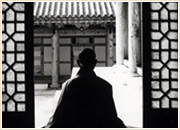 | 4 Years Spent with Korean Traditional Buddhist Culture Jaeun Sunim, a Canadian, was one of two bikkhunis who were the first to ordain following graduation from a traditional four-year seminary. |
| 4 Years Spent with Korean Traditional Buddhist Culture |
|
| How did you first become interested in Buddhism? |
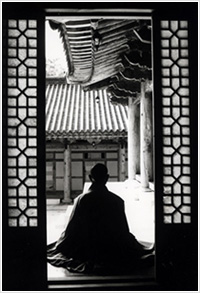 I think it would be truthful to say that I have always been a Buddhist. However, as I was born in a country where there is no indigenous Buddhist tradition, it was many years before I was able to recognize it. I think it would be truthful to say that I have always been a Buddhist. However, as I was born in a country where there is no indigenous Buddhist tradition, it was many years before I was able to recognize it. When I was in the first grade at school, a student asked our teacher, “Who made the world?” and she said, “God made the world”. Another student asked, “Then, who made God?” and she said, “We shouldn’t ask questions like that”. I remember asking, “Why not?” I had many questions about life that nobody seemed to want to talk about. My experiences with Christianity were similar: I was told to just have faith and that we shouldn’t try to understand the mind of God. These attitudes served to quell my interest in religion. So I redirected my inquisitiveness in a more “acceptable” direction and studied science, eventually majoring in biochemistry. When I was a university student, I did volunteer work with the local chapter of Amnesty International, and was shocked by the stories of torture and injustice that are committed so routinely around the world. I realized how well off and comfortable I was compared to most people in the world. My life seemed so useless in the face of all that suffering, and this brought back many of the unanswered questions of my childhood. So as a graduate student I did research in virology, with the idea that I could do some good in the world by helping to understand diseases so that they could be more effectively treated and prevented. At the same time, I started to read more in philosophy and psychology, and to explore some alternative spiritual paths. One day a friend told me she was learning to meditate and suddenly I found myself saying that I wanted to learn too. She loaned me a book by Vietnamese master Thich Nhat Hanh and as I read it, I simply knew that I was a Buddhist. My friend introduced me to a woman who was teaching meditation, and eventually I met her teacher, the late Venerable Namgyal Rinpoche, and other students of his who were teaching Buddha Dharma. From them, I began to learn the fundamentals of Buddhist theory and practice It was such a relief! In Buddhism, I not only found others who were asking the same kinds of questions that had nagged me since childhood, but a way of spiritual life in which this kind of questioning is in fact necessary and encouraged. |
In Canada, there are very few Korean Monks and Nuns, and little is known of Korean Buddhism. So how did you come to Korea, and to Korean Buddhism? |
As a postdoctoral research fellow, late one night in the lab, suddenly, very clearly, a thought appeared: “Even if every disease known to humanity could be cured, suffering would go on unabated because suffering originates in our minds, not our bodies”. After that, it seemed to me the only thing that could truly relieve the suffering in the world was Buddhist practice. My interest in my research career rapidly faded away. 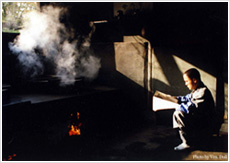 The next time I met the Venerable Namgyal Rinpoche, I told him about this, and he said that I should consider becoming ordained, which meant going to Asia, as there was no monastic community in Canada. But after so many years of university study, I had almost no money. One day, a small ad in the newspaper caught my eye: “Teach English in Asia, no experience necessary, free air ticket, room and board”. So I got a job as an English instructor in Korea, not because of Korean Buddhism, which I had never heard of, but because of the free ticket to Asia. My idea was to save a little money and travel around Asia exploring the options for Buddhist study and ordination. However, not long after I arrived, I met some Korean nuns and was impressed with their dedication, their independence and the wonderful opportunities for study and practice. I found the Korean Seon tradition very clear and straightforward as well. That was in the spring of 1998, and I’ve been here ever since. The next time I met the Venerable Namgyal Rinpoche, I told him about this, and he said that I should consider becoming ordained, which meant going to Asia, as there was no monastic community in Canada. But after so many years of university study, I had almost no money. One day, a small ad in the newspaper caught my eye: “Teach English in Asia, no experience necessary, free air ticket, room and board”. So I got a job as an English instructor in Korea, not because of Korean Buddhism, which I had never heard of, but because of the free ticket to Asia. My idea was to save a little money and travel around Asia exploring the options for Buddhist study and ordination. However, not long after I arrived, I met some Korean nuns and was impressed with their dedication, their independence and the wonderful opportunities for study and practice. I found the Korean Seon tradition very clear and straightforward as well. That was in the spring of 1998, and I’ve been here ever since. |
Sunim, you were one of the first two Western nuns to graduate from a traditional Buddhist seminary (gangwon), and now have received the bikkhuni ordination in the Jogye Order. Since graduation from seminary isn’t required for foreign monks and nuns to receive full ordination, why did you decide to do it? |
| Most Korean Bikkhunis believe that training in the seminary is necessary for novice nuns to provide a foundation for their monastic life and practice, and the vast majority of nuns in Korea attend the seminary for four years as the basic training before full ordination. The only way to really understand something is to experience it yourself. And for a Westerner to understand a particular Buddhist tradition, it’s important to get as close to the roots of that tradition as possible. Because Western culture is so different from Korean culture, life in the seminary would also teach me how to live together harmoniously with Korean nuns. So it seemed attending the seminary would be the best way for me to get a good foundation to monastic life and a deeper appreciation of the Jogye tradition and life as a Korean Buddhist nun. |
How was life in the seminary? |
| Seminary life is communal. We eat, sleep, study, and practice together in one room with everyone else. Communal work is also a large part of the life. Through this we learn to consider others first, putting the needs of the community before our own personal needs. At Cheongamsa, the nuns in the first three years (about 80 altogether) live together in one room; the fourth year nuns live together in a separate room. To live so closely together with many people means that one’s actions, moods and energy affect everyone in the whole group. Therefore one has to learn to act in harmony with the community as much as possible and to let go of one’s opinions and selfish desires. Anything one does that negatively affects others becomes immediately apparent, and one has to work to correct it. For me this was very difficult, but is actually a very deep training in mindfulness, and so also wonderful practice. |
As a Westerner, were there difficulties in adapting to the culture? |
2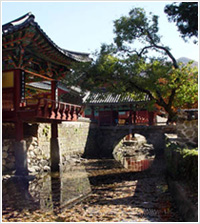 Western culture is more individualistic than Asian culture, so adapting to communal life is very challenging. I was amazed to learn how much of my way of thinking was intimately tied to my cultural background. The way of expressing oneself, mannerisms, expressions, and of course, language are all different. I sometimes felt completely exhausted from having to concentrate all the time, trying to be mindful of my words and actions. However, I found I couldn’t blame all my difficulties on cultural and linguistic differences. There were simply aspects of my personality that I needed to work on in order to be able to live harmoniously with others. Western culture is more individualistic than Asian culture, so adapting to communal life is very challenging. I was amazed to learn how much of my way of thinking was intimately tied to my cultural background. The way of expressing oneself, mannerisms, expressions, and of course, language are all different. I sometimes felt completely exhausted from having to concentrate all the time, trying to be mindful of my words and actions. However, I found I couldn’t blame all my difficulties on cultural and linguistic differences. There were simply aspects of my personality that I needed to work on in order to be able to live harmoniously with others. Then of course there was the textual study. The curriculum consists of Seon writings from China and Korea, and major Mahayana Buddhist Sutras. All of the texts are in Classical Chinese characters, which for me are very difficult. Also the method of studying is very different from how we study in Canada. The characters are read and simultaneously translated into Korean. The texts are memorized as much as possible, regardless of whether or not they are understood. After reciting a text many times, the meaning is said to appear naturally. The way I have studied since childhood is to discuss and understand the underlying meaning of the subject first, not to memorize text verbatim. When something is thoroughly understood, remembering it comes naturally. I found it nearly impossible to memorize texts and had a hard time adapting to the studies. |
Now that you have graduated and ordained as a bikkhuni, what will you do? |
| Of course the most important thing is to live the teachings, to experience the teachings, which cannot be done through academic study. Therefore daily meditation practice is very important. Eventually I hope to do retreats in various meditation centers throughout the country, to deepen my understanding of the teachings, However before I begin to do formal retreats, I will take some time to review the material we studied in the seminary and do some independent study and practice. I may also help with some translation of Korean Buddhist materials to English. The Korean Buddhist Seon tradition is still largely unknown outside of Korea, which is something I hope will begin to change, as I feel Korean Buddhism has a lot to offer to the international community. |
| The article courtesy of Lotus Lantern |
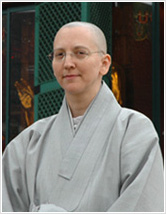 Although many non-Koreans have ordained in the Jogye Order, few have taken the bikkhu or bikkhuni ordination following study in the traditional seminary together with Korean monks or nuns. Because exceptions are made for foreigners, they can obtain full ordination without having to attend a traditional seminary.
Although many non-Koreans have ordained in the Jogye Order, few have taken the bikkhu or bikkhuni ordination following study in the traditional seminary together with Korean monks or nuns. Because exceptions are made for foreigners, they can obtain full ordination without having to attend a traditional seminary.
댓글 없음:
댓글 쓰기